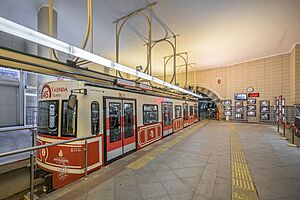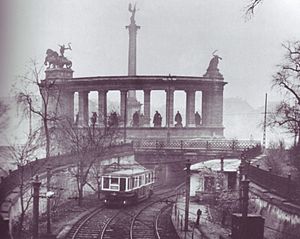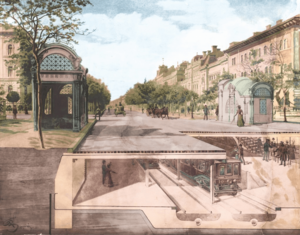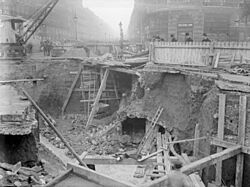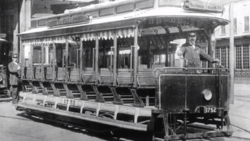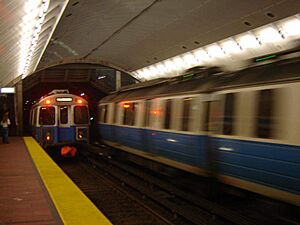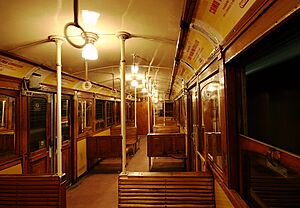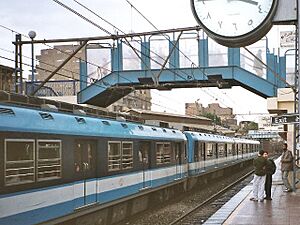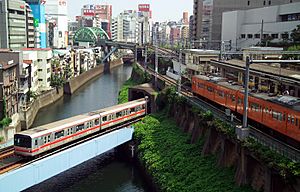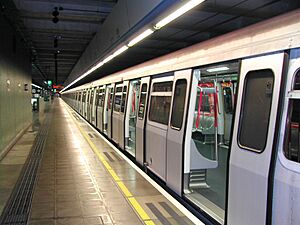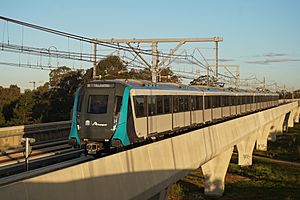History of rapid transit facts for kids
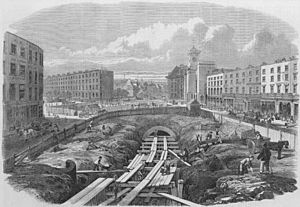

The story of rapid transit (also known as a metro, subway, or underground railway) began in London. The very first one, the Metropolitan Railway, opened in 1863. Today, this railway is part of the famous London Underground.
Before World War I (which started in 1914), many big cities around the world had already built electric underground railways. These included Athens, Berlin, Boston, Buenos Aires, Budapest, Glasgow, Hamburg, Istanbul, Liverpool, New York City, Paris, and Philadelphia.
In the 21st century, China has become the world leader in rapid transit. It has the most systems and is building new ones faster than any other country. Many other countries in Asia are also building their own rapid transit networks.
Contents
How Rapid Transit Developed
Early city railways that used steam trains had a big problem: smoke! This was especially bad in tunnels. However, elevated railways (trains running on tracks high above the ground) had less smoke trouble. The first elevated railway opened in New York City in 1870.
To solve the smoke problem in tunnels, London's City & South London Railway started using electric power in 1890. Electric trains were much better. They were more efficient, faster, and cleaner than steam trains. This made them the perfect choice for tunnels and even better for elevated lines.
The First Underground Tunnels
Before cities planned full subway systems, some railway companies already used tunnels for trains. These tunnels helped trains go through hills or difficult areas. For example, the Crown Street Tunnel in Liverpool was built in 1829. Part of the 1836 Lime Street Tunnel, also in Liverpool, is still used today. This makes it the world's oldest active railway tunnel!
The very first city underground railway was the Metropolitan Railway in London. It started running on January 10, 1863. Most of it was built using a method called "cut and cover". This meant digging a trench, building the tunnel, and then covering it up. Even with vents, the steam trains made the tunnels smoky and uncomfortable. People tried to invent pneumatic (air-powered) or cable-hauled railways to fix this, but none worked. Still, the Metropolitan Railway was very popular from the start.
The Metropolitan Railway and another company, the District Railway, worked together to create the "inner circle" around central London. This was finished in 1884. They also built many lines extending out to the suburbs. These systems eventually became part of the famous London Underground.
Trains Go Electric
In 1890, the City & South London Railway opened as the first electric underground railway in a city. Its tunnels were round, like tubes, which is why the London Underground is often called "the Tube." This railway was originally planned to use cables, but the company providing the cable technology went out of business. Since the law said they couldn't use steam, they chose electric power. Their trains had three carriages and, strangely, no windows at first! They thought passengers wouldn't need to see outside if they were in tunnels.
In 1893, Liverpool opened the UK's only elevated electric railway, the Liverpool Overhead Railway. It was the world's fourth metro system and the first fully elevated railway to use electric trains from the beginning. This railway was also the first to use Electric Multiple Units, which are trains where each car has its own motors. It also had automatic electric light signals. The "El" (as it was called) helped Liverpool get the nickname "Britain's North American City." The Liverpool Overhead Railway was taken down in 1957. Today, Liverpool has the Merseyrail network, which includes the old Mersey Railway that opened in 1886.
A big step forward for electric rapid transit happened in 1897. American inventor Frank J. Sprague successfully tested his system called multiple-unit train control (MUTC). This system allowed one person to control all the motors in an entire train from a single point. This meant rapid transit systems no longer needed separate locomotives to pull the cars.
Early Rapid Transit Systems
Europe
Istanbul's Tünel (F2) opened in 1875. It's the second-oldest underground city rail line in the world, after the London Underground. It's also the oldest underground funicular (a type of cable railway) in Europe. It still runs today, connecting Beyoğlu to Karaköy over a short distance of about 0.5 km (0.3 mi). Some people call Istanbul's 1875 Tünel an early subway, but it's actually an underground funicular.
Budapest opened the first electric underground line in mainland Europe, the M1, in 1896. It ran for about 3.7 km (2.3 mi) from the city center to City Park. This line is now part of the Budapest Metro and has been largely restored. It was very innovative for its time, with features like two-way tram cars and electric lighting in stations.
The Glasgow Subway in Scotland opened in the same year, 1896. It used cables to pull the trains until it was electrified in 1935.
In 1898, the Vienna Metropolitan Railway opened in Vienna. It used steam trains, which were already a bit old-fashioned. Three of its lines were later turned into a modern underground railway in 1978.
The first line of the Paris Métro opened in 1900. Its full name, Chemin de Fer Métropolitain, was a direct French translation of London's Metropolitan Railway. The name was shortened to métro, and many other languages have borrowed this word.
The Berlin U-Bahn (short for Untergrundbahn, meaning 'underground railway') opened in 1902. Because large parts of it were elevated, it was also called "Hochbahn" ('high railway') until the 1920s. Germany's second system, the Hamburg U-Bahn, opened in 1904.
The Athens-Piraeus Electric Railway started as a steam-powered suburban line in 1869. It got an underground section in the capital in 1874. It became electric in 1904 and is now part of the Athens Metro (Line 1). Two more lines were built between 1992 and 2000.
North America
New York City built its first rapid transit line, the West Side and Yonkers Patent Railway, in 1868. The New York City Subway, which is now one of the world's biggest rapid transit systems, opened its first section in 1904. This first part was a 9-mile (14.5 km) four-track line. Extensions were soon added, reaching the Bronx and Brooklyn. Over time, many existing elevated railway lines were added to the system.
The first Chicago L, the South Side Elevated Railroad, started operating in 1892. This system is known for its many elevated tracks, with some lines having no underground sections at all.
The Tremont Street Subway opened in Boston in 1897. It was North America's first electric subway tunnel and is still one of the oldest in use. It was built to help with streetcar traffic and is now part of the MBTA Green Line.
In 1907, the first line in Philadelphia began running. It used both elevated and underground tracks and is now part of the Market–Frankford Line.
South America
The oldest subway in the Southern Hemisphere is "Subterráneos de Buenos Aires" (Subte). It opened in 1913 in Buenos Aires, Argentina, as an underground tramway. Line A of the Subte used special wood and metal carriages called "La Brugeoise" cars. These cars were used continuously for 100 years before being replaced in 2013!
Later Rapid Transit Systems
Africa
Cairo was the first city in Africa to have a metro system, which opened in 1987. Some parts of it were changed from existing railway lines. The second African metro opened in Algiers in November 2011. Lagos and Abidjan are two other African cities that are also building metro networks.
Asia
East Asia
Asia's first cities to get subway lines were Tokyo in 1927 and Osaka in 1933. Other big Japanese cities with subway systems include Yokohama, Sapporo, Kobe, Kyoto, Fukuoka, Nagoya, and Sendai.
China's first metro system, the Beijing subway, started in 1971. Other major cities followed, like Tianjin (1984), Shanghai (1993), Guangzhou (1997), Wuhan (2004), and Shenzhen (2004). Almost sixty Chinese cities either have or are planning rapid transit systems, and new ones open every year!
In 1979, Hong Kong's subway line, the MTR, began operating. It has 10 lines, including four that go under Victoria Harbour.
Since 1974, cities in South Korea have built subway systems. The largest, Seoul, has twelve lines that stretch about 314 km (195 mi). Busan, Daegu, Incheon, Daejeon, and Gwangju also have subway systems. Seoul and Incheon are connected by metro.
Pyongyang in North Korea has a very deep and decorated metro. Its stations have unique, non-geographical names. It was also built to be a bomb shelter in case of war.
In 1996, Taiwan opened its first metro system in Taipei. A second metro system opened in Kaohsiung in 2008.
South Asia
India's oldest metro is in Kolkata, which opened in 1984. It was first planned in 1919. After that came the elevated Chennai MRTS. Later, cities like Delhi, Mumbai, Bengaluru, Chennai, Kochi, Hyderabad, Nagpur, Jaipur, and Ahmadabad built their own metros. Many other cities are building or planning metro lines.
The Lahore Metro in Lahore, Pakistan, opened in October 2020. It was the first automated and driverless rapid transit system in South Asia. It has 26 stations and is 27 kilometers long.
Bangladesh also opened its first metro in Dhaka on December 28, 2022.
Southeast Asia
Manila's Light Rail Transit is the oldest rapid transit system in Southeast Asia, opening in 1984.
In 1987, the Mass Rapid Transit in Singapore opened. It was the world's first "heavy rail" system to have platform screen doors at its underground stations. These doors separate the platform from the tracks for safety.
Kuala Lumpur's light rapid transit system has two lines that opened in 1996 and 1998. The MRT SBK line opened in phases in 2016 and 2017. All MRT stations and some LRT stations have platform screen doors.
The Jakarta MRT in Jakarta, Indonesia, opened in March 2019. It was Indonesia's first rapid transit line.
The BTS Skytrain opened in Bangkok, Thailand, in 1999, followed by the Bangkok MRT in 2004.
West Asia
Haifa, Israel, opened an underground funicular railway called the Carmelit in 1959.
Iran built its first metro network in Tehran in 1999. Its second, in Mashad, finished in 2011. Five more networks are planned for other Iranian cities.
In 2009, the UAE built an elevated metro in Dubai, which is one of the most modern in the world. Metros are also planned for Abu Dhabi and Sharjah.
In Mecca, Saudi Arabia, a 20 km (12.4 mi) metro line was finished in 2010. A total of 5 metro lines with long trains are planned to carry people around Mecca. Another metro opened in Riyadh in 2019.
Istanbul in Turkey built its metro in 1989. Other systems built in Turkey include Ankara (1997), Izmir (2000), Bursa (2002), and Adana (2009).
Europe (Continued)
Spain
The Madrid Metro opened on October 17, 1919. Its stations were used as air raid shelters during the Spanish Civil War. Today, Madrid's subway is one of the longest systems in the world. The Barcelona Metro followed in 1924.
Portugal
In 1959, a metro opened in Lisbon, called Metropolitano de Lisboa. It was the first underground rail system in the Portuguese-speaking world.
Post-Soviet States
In 1935, the Soviet Union built its first metro in Moscow. Other systems in countries that were once part of the Soviet Union include Saint Petersburg (1955), Kyiv (1960), Tbilisi (1966), Baku (1967), Kharkov (1975), Tashkent (1977), Yerevan (1981), Minsk (1984), Nizhny Novgorod (1985), Novosibirsk (1986), Samara (1987), Yekaterinburg (1991), and Almaty (2011).
United Kingdom (Continued)
In 1980, the second underground metro system in England, called the Tyne and Wear Metro, opened to serve Newcastle-upon-Tyne.
North America (Continued)
Canada
The Toronto Subway opened in 1954. Some of its early trains used aluminum cars, which were lighter and cheaper to run. The Montreal Metro was Canada's second subway system, opening in 1966 for Expo 67.
United States
The Bay Area Rapid Transit (BART) in the San Francisco Bay Area and the Metropolitan Atlanta Rapid Transit Authority (MARTA) both opened in 1972. The capital's Washington Metro in Washington, D.C. opened in 1976. These systems showed a new interest in rapid transit in the United States. In the 1980s, Baltimore and Miami also opened single-line rapid transit systems.
The most recently built fully underground heavy rail metro system in the continental United States is the Los Angeles Metro B and D Lines in Los Angeles. These lines opened in 1993.
Tren Urbano serves the island of Puerto Rico in and around its capital, San Juan. It is the Caribbean's first rapid transit system, opening in 2004.
Oceania
Australia's five largest cities have suburban railway networks. The Sydney Metro opened in 2019, bringing higher frequency services.
In New Zealand, the City Rail Link in Auckland started construction in 2016 after many years of planning.
South America (Continued)
Brazil
In Brazil, the first underground rapid transit service opened in 1974 in São Paulo. Today, the Metrô carries about 4 million passengers on an average weekday. Parts of it use older railway lines, with some stations dating back to the 1880s. Underground lines have also been built in Rio de Janeiro, Belo Horizonte, Recife, Porto Alegre, and Brasília.
Chile
Metro de Santiago is the metro system serving Santiago, the capital of Chile. It has five lines and 85 stations. It is the only South American metro that uses rubber tires on its trains.
Colombia
Medellín, Colombia, has one of the few metro systems in the world that actually makes a profit. It carries fewer than 500,000 passengers a day. This system runs on elevated tracks in the downtown area and at ground level next to the river.
See also
 In Spanish: Historia del metro para niños
In Spanish: Historia del metro para niños


